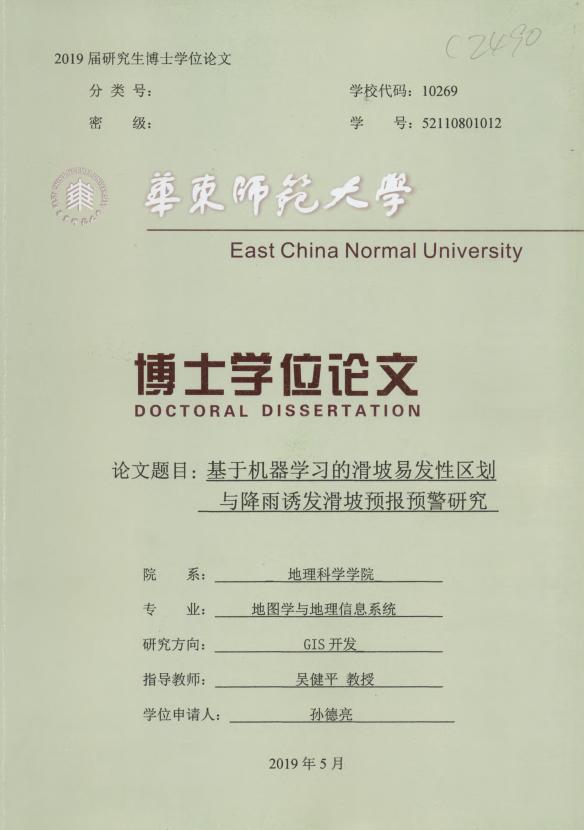| 英文摘要 |
The landslide is a process in which the slope body composed of rock, soil or debris deposits is affected by surface water, groundwater or earthquakes under the action of gravity, and the whole surface slides down along the weak surface (sliding surface). Landslide disasters can destroy residences and traffic lines cause property losses and casualties. Secondary disasters caused by landslides can also block rivers, cause floods, and even induce mudslides, which result in more serious losses. Southwestern China is the most serious area of landslide disasters as its wide distribution of mountainous areas with complex geological environment and hydro-climatic conditions. In this area, frequent landslides have greatly threatened people's lives and property. The landslide susceptibility zoning, also named as the evaluation of landslide susceptibility, is to estimate the geospatial distribution of potential landslide disasters through landslide hazard prediction. The landslide susceptibility zoning can make great contributes to landslide hazard prevention and urban construction planning. Most of the landslides in China are directly or indirectly induced by rainfall. Rainfall-induced landslide warning and forecasting can be used as effective information for government departments to formulate preventive measures at an early stage to reduce the loss of landslide disasters. In this study, Fengjie county, a typical western mountainous area in Chongqing province was selected as the study area. Machine learning method was used for Landslide susceptibility zoning and rainfall-induced landslide prediction. The research contents and results are as follows: (1)The data of 1520 landslide samples and various of environmental variables including geological structures, topography, precipitation, human activities, which occurred in the study area during 2001 to 2016 were collected and processed. The spatial distribution characteristics, genetic mechanism and development environment of the landslide hazard in the study area were analyzed. (2)Considering the complexity of the mechanism of landslide hazard and the diversification of predisposing factors, five main influencing factors including topography, geological conditions, environmental conditions, human engineering activities and inducing factors are selected. These factors specifically include 16 variables, which include elevation, slope, slope direction, slope position and micro Landform, ground curvature, topographic humidity index, lithology, distance fault distance, tilt type, NDVI (normalized vegetation index), distance from river, land use and land cover, distance from road, distance from building, and annual average precipitation. The correlation analysis was carried between each variables and the historical landslide samples to construct the evaluation index system for landslide susceptibility zoning. (3)Three kinds of machine learning methods, logistic regression, artificial neural network and random forest were used to carry out landslide susceptibility zoning. In order to construct an optimized machine learning model, bayesian optimization algorithm was used to optimize the model parameters and recursive feature elimination method was used to select features. Comparing landslide susceptibility zoning results from three different methods, the results of the random forest method are more in line with the actual situation. Furthermore, with the overlapping results of the landslide susceptibility map and the historical landslide samples, there are 65% of the historical landslides samples fall in the high-level susceptible area occupied less than 20% area. (4)Combined with the historical landslide and the corresponding precipitation data in the study area, the correlation analysis between precipitation and landslide was carried out, and the early effective rainfall calculation model of the landslide disaster in Fengjie county was set up. Based on the effective rainfall model, the data mining analysis of the landslide data located in the landslide susceptible areas of different levels was carried out, and the effective rainfall threshold of different warning levels of the landslide disaster in Fengjie county was proposed. According to the relationship between the daily rainfall and the historical landslide in different level landslide susceptible areas, the criteria of the early-warning level of the daily rainfall to the landslide are proposed. A spatio-temporal model for forecasting and warning landslide and rainfall in Fengjie county was constructed by combining the vulnerable regionalization, effective rainfall threshold and equivalent rainfall adjustment criteria. (5)Fengjie rainfall-induced landslides forecasting system was developed. This system integrates Fengjie landslide disaster data and its influence factors and can modelling landslide susceptibility zones though machine learning. It can used for the effective rainfall query and analysis, as well as the time and space coupling of rainfall - induced landslide forecast and visualization. (6)To verify results of modelling, five landslide cases in 2017 in study area were used as verification samples. Based on the landslide case record of precipitation in that day and before 10 days, the forecast level of precipitation was given by the system. The result shows a high accuracy and tally with the actual situation overall. Keywords: Fengjie county; Landslide; machine learning; susceptibility zoning; effective rainfall threshold; Joint forecasting and warning in space and time
|

